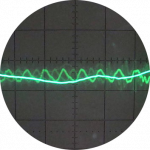Anyone able to provide some feedback before I make my finale decision? Samsung vs Baxi vs Vaillant
Posted by: @heatgeekOther angle is does reduced flow rate impact on any balancing of the rads?
Answer is, yes. Power set for a rad is the Flow x DT x SH-of-Water. So if you adjust the flow down, you will have to adjust DT upwards to achieve the same power output. This is what I believe Surrey has done to get a larger DT to start from, as DT "modulates" downwards. Reducing the fixed flow setting then obviously sets the maximum power out from the HP.
Id go for a definite maybe. The question was about balancing. If you adjust the flow overall down on a system where the radiators are balanced then all radiators will be affected roughly (but probably not exactly) equally. So they will remain roughly in balance. This means that the balancing may need to be tweaked, but equally it may not because balance is something of an approximation anyway, and only needs to be 'rough' because rooms share heat.
If the you set the flow too low then it wont be possible for enough heat to be transferred from the heat pump to the emitters. The heat pump may well complain at that point.
4kW peak of solar PV since 2011; EV and a 1930s house which has been partially renovated to improve its efficiency. 7kW Vaillant heat pump.
@jamespa Apologies. My last post was made before I read your response.
Posted by: @jamespawe cant be sure whether increasing DT (whilst maintaining house temperature) increases COP, reduces COP or makes no difference.
The answer is in your own diagram. Resultant internal DT is points 3 to 4 on the enthalpy diagram. If you reduce DT, you move up the curve, reducing enthalpy until DT is 0 at the critical pressure point and the HP throws a high pressure alarm. The question is, how does this arise? Normally, it is a result of the heat not being carried away from PHE e.g. low water flow. For a same level of flow, a higher DT carries away more heat, therefore is better. However, if a fixed high level of water flow is maintained (e.g. Vaillant?), then a low DT can carry away the same amount of heat than the other way around. So, maybe we can agree that it is not only DT but a combination of DT and flow that is important i.e. the heat power absorption capability of the water flow that determines COP.
Private individual. No affiliation with commercial "Heat Geeks" of same coincidental name.
Posted by: @heatgeekResultant internal DT is points 3 to 4 on the enthalpy diagram. I
Not so sure about that. Points 3-4 are on a constant (refrigerant) temperature line, which you can see because refrigerant temperature is on the diagram and occurs because this is the condensation phase.
I imagine that the bulk of the heat transfer from refrigerant to water occurs during this phase, and therefore that this constant refrigerant temperature must be above the water temperature in order for the heat transfer to take place.
Posted by: @heatgeekSo, maybe we can agree that it is not only DT but a combination of DT and flow that is important i.e. the heat power absorption capability of the water flow that determines COP.
The primary determinants are still the required flow temperature and OAT, that's clear from the manufacturers data. In terms of the diagram I think this determines how far up the curve you need to go (and therefore to what level the compressor must modulate) in order that the refrigerant temperature exceeds the desired flow temperature, and how far down you start. These in turn determine the length and energy in the 'work' section 1-2.
I can certainly see that a combination of DT and flow is highly likely to have a secondary effect on COP.
4kW peak of solar PV since 2011; EV and a 1930s house which has been partially renovated to improve its efficiency. 7kW Vaillant heat pump.
@jamespa Yes, you are right, I was misreading the diagram. ☹ The main point that I was trying to make, however, is that the heat has to be carried away efficiently or a high pressure alarm will occur, and for this to happen you do not need to have a high DT across the PHE. Vaillant obviously does it by maintaining a high water flow rate and therefore DT is low, but the heat carried away is the same. Therefore a prerequisite for (external) high DT across the PHE is erroneous.
Private individual. No affiliation with commercial "Heat Geeks" of same coincidental name.
@jamespa Further to the conclusion in my previous post, I must eat humble pie and apologise for trying to reconcile water flow DT with improvement in COP. There is no correlation. Can I have another go?
Going back to basics, COP is the ratio of heat power out relative to power input. This is related to the heat generated internally in the HP, and water flow and DT are related to delivering this heat out of the HP to emitters. As I said in a previous post, the COP of a HP is related to the mean condensation temperature and to the air source temperature (evaporation temperature). It is stupidly simple from your diagram that, given a fixed OAT, the condensation temperature relates to heat output (flow temperature), and the lower the condensation temperature line, the closer it moves to the evaporation line and reduces the compressor power required (points 1 – 2), therefore COP increases.
Likewise, if OAT increases, for a fixed flow temperature, the bottom line moves up and likewise improves COP by reducing compressor power needed. The best COP is obtained by having a low flow temperature coupled with a high OAT. Likewise a high flow temperature (for DHW) coupled with very low OAT gives the worst COP as high compressor power is needed. The exact level of COP is a design issue.
The water flow through the PHE only has to remove the heat generated by the HP. It does not matter what the combination of DT and flow is, so long as it is efficient. So, therefore I assert that DT does not affect COP. If OAT rises and the rads cannot get rid of the heat, the return flow temperature will start to increase. This will tend to raise temperature in the PHE. The HP will counter this by lowering the mean condensation temperature (flow temperature) through lower compressor power and COP will increase in line with OAT. WC parameters also allows the HP to set predetermined flow temperatures.
In summary therefore, my assertion that high water flow DT improves COP is manifestly wrong. High DT with low flow (Samsung) is the same as low DT with high flow (Vaillant) in terms of transporting heat out. The main issue with high DT relative to low DT is the ability of the HP to detect flow temperature variation. 10% of 2C is 0.2C compared to 0.5C for 5C. As long as the HP can handle this, there is no issue.
Apologies for flip-flopping.
Private individual. No affiliation with commercial "Heat Geeks" of same coincidental name.
Thanks All! I am impressed by the quality of the scientific discourse here and I hope this thread has been of general benefit. I will take some more time to process all this as I am totally out of my depth here...
Still waiting for the last quote from Sustain. I will send them another reminder next week.
Have a lovely weekend!
E
Firstly thank you for all this discussion as a result of which i have (I think) understood the way heat pumps operate better than ever before. TBH its the first time I had begun to understand the enthalpy-pressure diagram (its not my diagram, its a link to another site). Every day is a school day!
Posted by: @heatgeekGoing back to basics, COP is the ratio of heat power out relative to power input. This is related to the heat generated internally in the HP, and water flow and DT are related to delivering this heat out of the HP to emitters. As I said in a previous post, the COP of a HP is related to the mean condensation temperature and to the air source temperature (evaporation temperature). It is stupidly simple from your diagram that, given a fixed OAT, the condensation temperature relates to heat output (flow temperature), and the lower the condensation temperature line, the closer it moves to the evaporation line and reduces the compressor power required (points 1 – 2), therefore COP increases.
Likewise, if OAT increases, for a fixed flow temperature, the bottom line moves up and likewise improves COP by reducing compressor power needed. The best COP is obtained by having a low flow temperature coupled with a high OAT. Likewise a high flow temperature (for DHW) coupled with very low OAT gives the worst COP as high compressor power is needed. The exact level of COP is a design issue.
I agree and I think we can now go further with the explanations. In a heat pump with a fixed speed compressor (ie a very old one) the only compressor variable, as I understand it, was the condensation temperature. Thus both the power output generated by the cycle and the flow temperature are determined by the condensation temperature, which in turn is determined by the compression ratio (how far up the pressure axis you go in the enthalpy pressure diagram). I imagine that the compression ratio is set by a valve which opens at a point in the cycle controlled by the desired flow temperature, presumably so that the condensation temperature is just above the desired flow temperature in order to effect heat transfer in the PHE whilst not excessively pressurising and compromising COP.
However all modern heat pumps are inverter driven at a variable speed, often described in revolutions per second or as a frequency. You can see from the performance curves (examples below) that the power output and the (flow) temperature at which it produces it are now (quasi) independent. From the terminology I assume (I dont know for certain) that rps/frequency is the number of times the cycle occurs each second. So we now do indeed have two variables, the point at which the valve opens in the compression phase, which determines the compression ratio, hence the condensation and flow temperatures, and the number of times the cycle occurs each second, which determines the power output.
The upshot of this is that the heat pump can adjust its power output to match the load whilst keeping the flow temperature constant, always presuming that the load is within its modulation range and that there is sufficient transport capacity - ie water flow - available.
4kW peak of solar PV since 2011; EV and a 1930s house which has been partially renovated to improve its efficiency. 7kW Vaillant heat pump.
@eliuccio I did post to you before but the app seems to have swallowed my content and posted your user name only. The app AI software obviously did not agree with what I had to say. Let me try again.
From the varied discussions that have taken place, I have come to my own view about your system. I previously recommended the Samsung but have now changed my mind in light of the discourse. The 5kW Samsung HP is over-sized but does not specify a low power output because its minimum power is determined by the 7 l/min flow switch i.e. ~2.6kW after margin added. The 3.5kW and 5kW Vaillant both quote a low power of ~2kW therefore appear to be the same unit with programmed power reduced on one. The 5kW is therefore better for low temps unless there is a significant price difference which is unlikely. Minimum flow quoted is ~6 l/min which stacks up with the low power output figure. The Vaillant is therefore better for your application. As two-thirds of your power output is downstairs you can add TRV´s to bedrooms to control temperatures to 18C, given the uncertainty of upward heat flow from downstairs. The Vaillant has a nice facility to communicate room temperature value to the HP via e-bus, whereby flow temperature can be adjusted further from WC by the HP. The controller should be located in the lounge. For a compact house this could be important when additional heat sources kick in, e.g. solar gain, visitors, cooking, etc. This combination of control will save more money than pure WC/open loop IMHO. This HP would appear to be the best for the average compact UK house vis a vis Samsung and Daikin. The Samsung/Daikin DT controlled HP´s are better for larger, more lossy houses where effective zone control is desired and DT can be maintained automatically across UFH loops.
As a long time Samsung user, I never thought I would be opting for a Vaillant HP but we all live and learn and have to adapt to reality.
Private individual. No affiliation with commercial "Heat Geeks" of same coincidental name.
@eliuccio Hi, I don't regularly check in to these forums, so only just noticed your query. I live in north Essex and have a Samsung Gen 6 unit. If you want to direct message me, I would be happy to share my experience with you, as it's not been good. Don't want to get involved in public forums on this, it's still under warranty.
@dak51 There’s no harm in speaking publicly, whether your heat pump is under warranty or not. Samsung has a poor reputation for customer support across all its products, not just heat pumps. Most people use handles on these forums, so it’s highly unlikely that Samsung (or any other manufacturer) will connect the dots.
These forums exist so we can learn from each other’s experiences. Taking discussions into private chats prevents others from benefiting from your insights and making informed decisions… especially when it comes to choosing the right brand.
The more info that’s out there in the public domain, the better.
Get a copy of The Ultimate Guide to Heat Pumps
Subscribe and follow our YouTube channel!
@dak51 I also would be very interested in your experience. I have read your initial posts on the subject from 3 years ago. I have a self-built, well-insulated house of same size (200sqm) with UFH and MVHR, even Heatmiser stats. I have a 4kW Gen 4 Samsung with internal PWM pump (with DT control) running this and it has been operating flawlessly for 10 years now with minimal servicing so I cannot fault its quality. I would be interested to compare notes on what your system configuration is compared to mine. The Samsung does have its quirks like the 7 l/min flow meter but catastrophic failures like you have reported are highly odd.
Private individual. No affiliation with commercial "Heat Geeks" of same coincidental name.
- 26 Forums
- 2,342 Topics
- 53 K Posts
- 673 Online
- 6,000 Members
Join Us!
Worth Watching
Latest Posts
-
RE: Heat Pump Performance Analysis Web App using Modbus Data
I have created a beginners guide to provide a walkthrou...
By redzer_irl , 3 hours ago
-

RE: Setback savings - fact or fiction?
PS by visually merging the two tables as above, I ended...
By cathodeRay , 8 hours ago
-
RE: Samsung ASHP scheduling help
Correction to the post above (my time to edit has run o...
By redzer_irl , 9 hours ago
-

RE: Homely for Daikin Altherma 3 - Petersfield Area
@russ If you would care to pose your questions on one o...
By Toodles , 11 hours ago
-

RE: A Smarter Smart Controller from Homely?
@papahuhu I have a feeling that my Homely smart control...
By Toodles , 11 hours ago
-

RE: The good, the bad and the not that great – my heat pump installation
@cathoderay the guy I spoke to on the phone seemed very...
By Burtis , 20 hours ago
-
RE: Configuration issues with 10kW Midea R32 heat pump
Sorry that was a screenshot of @curlyKatie - mine has...
By SteveT , 24 hours ago
-
Different dT on each radiator?
All supplier surveys I've had, as well as tools like He...
By medwardz , 1 day ago
-
RE: British Gas vs Octopus Energy vs Heat Geek vs EDF vs Aira vs OVO vs EON.Next vs Boxt
I get the impression that that comment "they don't comm...
By JamesPa , 1 day ago
-

@majordennisbloodnok Just in case there are variations ...
By Toodles , 1 day ago
-

RE: Latest NIBE model has known defect and no solution
@kings I’m glad I could help. NIBE are taking this very...
By Mars , 1 day ago
-
RE: Octopus Cosy Heat Pump Owners & Discussion Thread
@jamespa yes, I'm under no illusions but in some respec...
By AndrewJ , 1 day ago
-
RE: Poll for Time of Use, tariffs, technology
@majordennisbloodnok thanks. Unfortunately i can't upd...
By Tim441 , 1 day ago
-
RE: Electricity price predictions
It seems the end of cfd payments is in sight, even if a...
By Batpred , 1 day ago
-
-
@pie_eater Yes, I installed Homely to a Daikin heat pum...
By gery , 2 days ago
-
RE: Havenwise App Help & Forum Support – Get the Most from Your Heat Pump
@davidalgarve Potentially stupid question, but are you ...
By Sheriff Fatman , 2 days ago
-
RE: What a Bad Heat Pump Installation Looks Like
Spot on, for relatively little money, an air of ready "...
By Batpred , 2 days ago
-
RE: Replacing my 18 month old Hitachi Yutaki ASHP
@trebor12345 Ok that makes more sense and leads is i...
By JamesPa , 2 days ago







